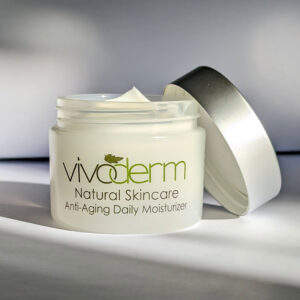
Embrace Spring with a Refreshed Skincare Routine
As we bid adieu to the cold, harsh winter and welcome the gentle warmth of spring, it’s not just our wardrobes that need a seasonal overhaul. Our skin, having braved the winter chills, now faces a new set of challenges with the changing weather. The arrival of spring calls for a refreshed skincare routine that caters to the evolving needs of your skin. Let’s dive into how you can transition your skincare regimen to embrace the vibrant energy of spring.
- Lighten Up on Moisture

Winter skincare is synonymous with heavy, rich moisturizers designed to combat dryness. However, as the mercury rises, it’s time to switch to lighter formulas. Opt for a lightweight, non-comedogenic moisturizer that hydrates without weighing your skin down. Oil-free moisturizers can be particularly refreshing and are ideal for maintaining balance as temperatures warm. The Vivoderm Anti-Aging Daily Moisturizer is a perfect transition for the warmer weather!
- SPF: Your Non-Negotiable Companion ☀️
The cornerstone of spring skincare is robust sun protection. With days getting longer and the sun shining brighter, shielding your skin from UV rays is crucial. Make sunscreen a non-negotiable part of your morning routine, choosing a product with at least SPF 30. Remember, UVA and UVB protection is essential, even on cloudy days, as harmful rays can penetrate through the clouds.
- Exfoliate with Care
Shedding the dullness of winter skin begins with proper exfoliation. Transitioning into spring, it’s important to slough off dead skin cells to reveal a brighter, more even complexion. Incorporate a gentle exfoliant into your routine, choosing between mechanical exfoliators or chemical exfoliants like AHAs (glycolic acid) and BHAs (salicylic acid). However, moderation is key—over-exfoliating can lead to irritation and sensitivity.
- Antioxidant Power
Spring is the perfect time to bolster your skin’s defense against environmental aggressors. Antioxidants like vitamin C, vitamin E, and ferulic acid not only protect against free radical damage but also brighten the skin and help reduce the appearance of dark spots. Incorporating a serum enriched with antioxidants in the morning can provide a protective barrier against pollutants and enhance your skin’s natural radiance.
- Stay Hydrated Inside and Out
Hydration is a year-round necessity. As we enjoy more outdoor activities, keeping our skin and body hydrated becomes even more important. Continue to drink plenty of water throughout the day and consider using a hydrating serum or essence to keep your skin plump and nourished.
- Tailor to Your Skin’s Needs
Finally, listen to your skin. The transition from winter to spring can vary in its effects on different skin types. Pay attention to how your skin responds to changes in your routine and be ready to adapt. Whether it’s incorporating more hydrating products, reducing exfoliation, or seeking out specific treatments for spring-related skin concerns, customization is key.
Embracing the Season
Spring is a season of renewal and growth, not just for nature but for our skin as well. By adapting your skincare routine to the changing climate, you can ensure that your skin remains healthy, radiant, and ready to enjoy the beauty of spring. Remember, the goal is to support your skin’s natural balance and protect it from seasonal challenges, ensuring a smooth transition into the warmer months ahead.








 Face is undoubtedly the most prominent of all body parts. More than any body part face commands daily and effective skincare. Facial skincare is a three steps easy way. Deep facial cleansing, facial nourishing and facial moisturizing are three steps to a great facial skin.
Face is undoubtedly the most prominent of all body parts. More than any body part face commands daily and effective skincare. Facial skincare is a three steps easy way. Deep facial cleansing, facial nourishing and facial moisturizing are three steps to a great facial skin. Every one wants to have blemish-free skin that can catch any one’s eye. You will be overwhelmed to know that it is possible to own such skin type with natural skin care treatments. Yes, it is true that with these treatments anyone can look beautiful and blemished free. Generally, these problems arise due to lack of essential vitamins and minerals in the body. Vital body nutrients like biotin, pantothenic, niacin, riboflavin, etc, are required to have a healthy glowing skin.
Every one wants to have blemish-free skin that can catch any one’s eye. You will be overwhelmed to know that it is possible to own such skin type with natural skin care treatments. Yes, it is true that with these treatments anyone can look beautiful and blemished free. Generally, these problems arise due to lack of essential vitamins and minerals in the body. Vital body nutrients like biotin, pantothenic, niacin, riboflavin, etc, are required to have a healthy glowing skin. With the chilly winds already bidding adieu it’s time to take out those sporty shorts and T-shirts for a stroll on the beach or a run in the park You’ve done the push-ups and the crunches in anticipation for the skin-revealing days ahead. You want to look your best, and taking good care of your skin is a part of that. So you spent most of the winter indoors, watching too much TV or gaming? Say goodbye to those baggy eye circles and dull skin by treating yourself to a detoxifying skin mask or a facial scrub and gear up for summer!
With the chilly winds already bidding adieu it’s time to take out those sporty shorts and T-shirts for a stroll on the beach or a run in the park You’ve done the push-ups and the crunches in anticipation for the skin-revealing days ahead. You want to look your best, and taking good care of your skin is a part of that. So you spent most of the winter indoors, watching too much TV or gaming? Say goodbye to those baggy eye circles and dull skin by treating yourself to a detoxifying skin mask or a facial scrub and gear up for summer! 1 – melanocyte
1 – melanocyte